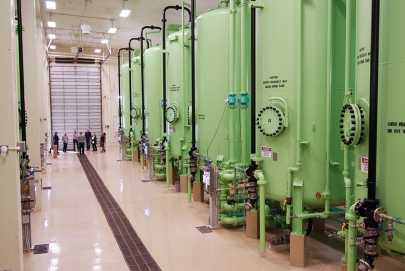Findings underscore need to reduce use of “forever chemicals”

A new report published by the Minnesota Pollution Control Agency (MPCA) finds that technologies and expenses needed to remove and destroy per- and polyfluoroalkyl substances (PFAS) from certain wastewater streams across Minnesota would cost between $14 and $28 billion over 20 years. The study is the first of its kind and, although specific to Minnesota, the novel methods developed to estimate costs can be applied anywhere.
The MPCA commissioned the independent study as part of Minnesota’s PFAS Blueprint, a comprehensive interagency plan to prevent, manage, and clean up PFAS pollution. The report, titled Evaluation of Current Alternatives and Estimated Cost Curves for PFAS Removal and Destruction from Municipal Wastewater, Biosolids, Landfill Leachate, and Compost Contact Water, was prepared by Barr Engineering Company and Hazen & Sawyer with funding from the Minnesota Environment and Natural Resources Trust Fund.
“The exorbitant costs associated with removing PFAS from community wastewater systems underscores the need to address PFAS pollution long before it gets into the waste stream,” said MPCA Commissioner Katrina Kessler. “At no fault of their own, wastewater treatment facilities receive PFAS from a variety of sources and they cannot carry the burden of cleaning up the pollution. We must all focus on preventing PFAS from entering the environment in the first place.”
Unaffordability of PFAS cleanup from wastewater
The full report will be of interest to the wastewater management and scientific communities. Key findings of broader interest include:
- Removing and destroying PFAS from water and biosolids leaving Minnesota’s wastewater treatment facilities could cost between $14 billion and $28 billion over 20 years.
- PFAS can be bought for $50 - $1,000 per pound (according to MPCA estimates), but costs between $2.7 million and $18 million per pound to remove and destroy from municipal wastewater, depending on facility size.
- Small wastewater treatment facilities would face per-pound costs over six times greater than large facilities, due to economies of scale.
- New “short-chain” types of PFAS are more difficult and up to 70% more expensive to remove and destroy compared to old “long-chain” PFAS.
Cost estimates are based on the required upgrades to Minnesota’s existing wastewater infrastructure to treat and destroy PFAS using current commercially available technologies and PFAS levels. In total, 13 PFAS removal and destruction technologies passed a screening on their real-world effectiveness and the most cost-effective technology was selected for statewide cost development. Complete details and additional findings are found in the full report.
New technology that reduces costs to remove and destroy PFAS from wastewater is in development, but the MPCA believes that without an alternative source of funding, PFAS removal and destruction from municipal wastewater will be unaffordable for the foreseeable future. In contrast, emerging biosolids technologies capable of destroying PFAS can be cost-competitive with current practices.
PFAS in wastewater
PFAS can enter wastewater through industrial processes, everyday use of commercial products, or when PFAS-containing products are discarded in landfills and compost sites. Even decades after they are brought to a landfill or compost site, PFAS can make their way into liquids called landfill leachate and compost contact water. These liquids are often sent to wastewater treatment facilities that are not designed to remove PFAS and ultimately released into the environment, where PFAS can contaminate surface water, groundwater, drinking water, fish, other wildlife, and the food supply. Targeting PFAS in wastewater streams, as the study assesses, would be a significant step toward protecting these resources.
Minnesota’s wastewater treatment facilities recognize the need to address PFAS pollution. They have begun monitoring for PFAS and completing PFAS source identification work, but no municipal wastewater facility has the infrastructure capable of removing and destroying PFAS.
Managing and preventing PFAS pollution
Minnesota’s PFAS Blueprint prioritizes pollution prevention as the most effective way to protect health and the environment, and the new PFAS wastewater cleanup cost estimates add a greater urgency to prevention efforts in Minnesota and elsewhere.
The MPCA is working to implement a new law passed by the Minnesota Legislature and signed by Gov. Tim Walz to phase out nonessential PFAS use over the coming decade. The Legislature also funded PFAS Blueprint programs to help businesses transition away from PFAS, protect drinking water supplies, and enhance monitoring systems.